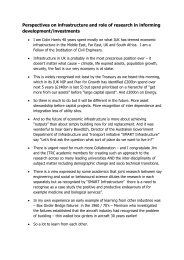A Fast Track Analysis of ICT Constraints on Evolving Physical ... - ITRC
A Fast Track Analysis of ICT Constraints on Evolving Physical ... - ITRC
A Fast Track Analysis of ICT Constraints on Evolving Physical ... - ITRC
You also want an ePaper? Increase the reach of your titles
YUMPU automatically turns print PDFs into web optimized ePapers that Google loves.
3 Key issues and opti<strong>on</strong>s<br />
This secti<strong>on</strong> outlines the main issues appearing within the <str<strong>on</strong>g>ICT</str<strong>on</strong>g> sector. The sector has witnessed rapid change<br />
and a number <str<strong>on</strong>g>of</str<strong>on</strong>g> issues relate to keeping up with the change and growth for the upcoming years. Some <str<strong>on</strong>g>of</str<strong>on</strong>g> the<br />
opti<strong>on</strong>s given for the issues are already being put in place, or are in the future plans. Within <str<strong>on</strong>g>ICT</str<strong>on</strong>g>, the majority<br />
<str<strong>on</strong>g>of</str<strong>on</strong>g> opti<strong>on</strong>s are technological - this comes from the fact that <str<strong>on</strong>g>ICT</str<strong>on</strong>g> is highly privately driven. Furthermore,<br />
reports advise against policy opti<strong>on</strong>s, instead encouraging creating ec<strong>on</strong>omic pull-through. The government<br />
cannot drive the sector – government decisi<strong>on</strong>s should be driven by the requirements/developments in the<br />
<str<strong>on</strong>g>ICT</str<strong>on</strong>g> sector (Horrocks et al., 2010).<br />
3.1 Increasing dependability <str<strong>on</strong>g>of</str<strong>on</strong>g>/dependence <strong>on</strong> <str<strong>on</strong>g>ICT</str<strong>on</strong>g><br />
It is informative to look backwards 50 years in the 1960s a (huge) mainframe was supported by a team <str<strong>on</strong>g>of</str<strong>on</strong>g><br />
<strong>on</strong>-site hardware engineers. Today, a small laptop has n times the storage and is m times as fast – and we<br />
expect it to run without failure for years!<br />
On the s<str<strong>on</strong>g>of</str<strong>on</strong>g>tware side, all programs were bespoke and the programmers were <strong>on</strong> call – today, commodity<br />
operating systems, programming languages, database management systems communicati<strong>on</strong>s s<str<strong>on</strong>g>of</str<strong>on</strong>g>tware and<br />
GUI builders make it relatively easy and quick to develop applicati<strong>on</strong>s that were unthinkable five decades<br />
ago.<br />
It is however essential to note that as “dependability” has increased, so has dependence. Many computers<br />
are deployed in systems that are financially, militarily or safety critical. Computer failures can stop a bank<br />
functi<strong>on</strong>ing (seen most rapidly in the loss <str<strong>on</strong>g>of</str<strong>on</strong>g> ATM support to customers); the primary protecti<strong>on</strong> systems <str<strong>on</strong>g>of</str<strong>on</strong>g><br />
nuclear power reactors are comm<strong>on</strong>ly computers running s<str<strong>on</strong>g>of</str<strong>on</strong>g>tware designed to protect safety; modern cars<br />
c<strong>on</strong>tain tens to hundreds <str<strong>on</strong>g>of</str<strong>on</strong>g> embedded computers that c<strong>on</strong>trol things as crucial as their braking systems.<br />
Any complex system can fail but today the failure can come from other than the obvious physical<br />
comp<strong>on</strong>ents such as turbines and motors; system failure can be caused by embedded c<strong>on</strong>trol systems. This<br />
can be hardware (although this is the easiest thing to protect by redundancy), s<str<strong>on</strong>g>of</str<strong>on</strong>g>tware or malicious attack.<br />
A dramatic example <str<strong>on</strong>g>of</str<strong>on</strong>g> s<str<strong>on</strong>g>of</str<strong>on</strong>g>tware failure c<strong>on</strong>tributing to a major power outage was the US Northeast Blackout<br />
<str<strong>on</strong>g>of</str<strong>on</strong>g> 2003.<br />
Randell et al. (Randell, 2000) gives both a detailed analysis <str<strong>on</strong>g>of</str<strong>on</strong>g> “faults/errors/failures” and ways <str<strong>on</strong>g>of</str<strong>on</strong>g><br />
mitigating their impact.<br />
As computers have become smaller and less expensive, they have become more pervasive. Fifty years<br />
ago, they were <strong>on</strong>ly operated by trained experts – today they are <strong>on</strong> every<strong>on</strong>e’s desk and few tasks can be<br />
completed without them. This has led to an increasing reliance <strong>on</strong> the interacti<strong>on</strong> between the people involved<br />
in an overall system and the design <str<strong>on</strong>g>of</str<strong>on</strong>g> dependable computer systems – this goes far deeper than what is<br />
known as “HCI” issues. The (EPSRC-funded) “Interdisciplinary Research Collaborati<strong>on</strong> <strong>on</strong> Dependability”<br />
(DIRC) studied such issues (see Besnard et al., 2006).<br />
3.2 Hardware (computati<strong>on</strong>)<br />
Computati<strong>on</strong>al capacity follows “Moore’s law” and has grown exp<strong>on</strong>entially. However, a limit is appearing<br />
as circuits approach atomic levels. Alternatives are being developed to replace silic<strong>on</strong> in semic<strong>on</strong>ductors and<br />
would allow Moore’s law to c<strong>on</strong>tinue to hold for l<strong>on</strong>ger (Radisavljevic et al., 2011). Another opti<strong>on</strong> is to<br />
produce “3D” wafers (performance declines dramatically with “<str<strong>on</strong>g>of</str<strong>on</strong>g>f wafer” c<strong>on</strong>necti<strong>on</strong>s which are by necessity<br />
l<strong>on</strong>ger – any way <str<strong>on</strong>g>of</str<strong>on</strong>g> getting more processor power <strong>on</strong> a wafer will retain the speed that results from the speed<br />
<str<strong>on</strong>g>of</str<strong>on</strong>g> light covering minute distances).<br />
While the alternative materials are being explored, the current trend to circumvent the computati<strong>on</strong> power<br />
limits is moving to multi-core. This way multiple processors perform computati<strong>on</strong>s in parallel. For hardware<br />
designers, this is an easy way forward but it poses significant challenges for s<str<strong>on</strong>g>of</str<strong>on</strong>g>tware designers. Whilst it<br />
is true that there are specific algorithms that lend themselves to parallelism, designing such programs in<br />
general is far more challenging than (standard) sequential programming. Gene Amdahl also has a “law”<br />
named after him, which suggests that there is a diminishing return <strong>on</strong> extra parallelism. Some find his<br />
observati<strong>on</strong> too pessimistic – but it is certainly true that parallel programming requires more care and skill.<br />
10



